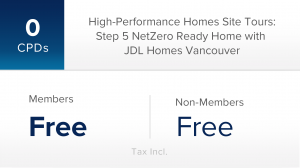The preferred process to reach Step Code targets and put the builder in control of the project.
Integrated Design Process
Watch this 5-minute video, packed with homeowner and builder benefits.
The Integrated Design Process (IDP) is the recommended practice to achieve the best outcome for the builder and homeowner when building a home to meet the higher levels of BC Energy Step Code. IDP brings together all the professional services in the pre-construction phase to empower the builder to better control the project. Blower door tests are used to measure airtightness of the project mid-construction, and on completion of the project.
Free Site Tours and Blower Door Test Videos
HAVAN is offering free videos showcasing Step 3 and Step 5 home tours, featuring live blower door tests. Great learning tools for you to share with employees, trades and sub-trades, ensure everyone on your job sites keep up with the integrated design process and the BC Energy Step Code requirements. It will help your bottom line!
Share these free videos.
Educate your staff and trades.
BC Energy Step Code
The Provincial Government introduced the BC Energy Step Code (www.energystepcode.ca ) in 2017 as an optional compliance path in the BC Building Code to help BC meet its goal to have all new buildings be net-zero energy by 2032. The Step Code supports local governments to incentivize or require net-zero energy in new construction that goes above and beyond the requirements of the BC Building Code. The Code identifies a recommended, phased approach of five levels, with Step 3 targeted for 2022, Step code 4 by 2027 and the final step implemented by 2032. The metrics vary by climate zone, measure a building’s airtightness, heating needs, and mechanical system efficiency.
Working with Energy Advisors

Using the Integrated Design Process, you will engage multiple consultants, including an Energy Advisor.
An EnerGuide* label provides details about the home’s energy performance, including how much energy is used for heating, cooling, ventilation, etc. and means the home has been third-party verified by an energy advisor registered with Natural Resources Canada, adding value and peace of mind to your client’s investment.
CHBA BC is licensed by Natural Resources Canada, and delivers EnerGuide*, ENERGY STAR®, R-2000*, and the CHBA Net Zero Home Labelling Program.
NRCan Cost Benefit Analysis Tool
Evaluating cost differences between code-minimum and higher-performance Step Code built homes
If clients are concerned about future-proofing the value of their new home, they may ask about the difference in cost between a code-minimum home and one that meets the 2022 (Step 3), 2027 (Step 4) or 2032 (Step 5) requirements.
How does a builder approximate this difference? NRCan’s Cost Benefit Analysis Tool (CBAT) is a powerful and free Excel-based costing tool that can help the Part 9 building community approximate the cost of high-performance homes of the future.
CBAT allows builders and energy advisors (EAs) to identify cost-effective technologies and envelope packages that meet the goals of their project and satisfy building codes and desired performance targets.
CBAT includes a costing database that can be used for cost calculations as is, or customized to local prices.
Optimal solutions using CBAT can include:
lowest cost to build
lowest cost to operate
lowest total cost of ownership
lowest operational carbon and more.
To access this valuable tool and other valuable resources, contact BC Housing at technicalresearch@bchousing.org. CBAT was the topic of a recent ZEBx – HAVAN webinar, and the presentation slide deck is now available for viewing.
High-Performance Home Owner Benefits
Understanding client benefits
It’s important to understand homeowners can benefit beyond lower energy bills when building and renovating homes to higher Energy Step Levels. Check out Your Home is Your Castle on HAVAN’s High-Performance Home page and empower yourself with information to help communicate with your clients.














